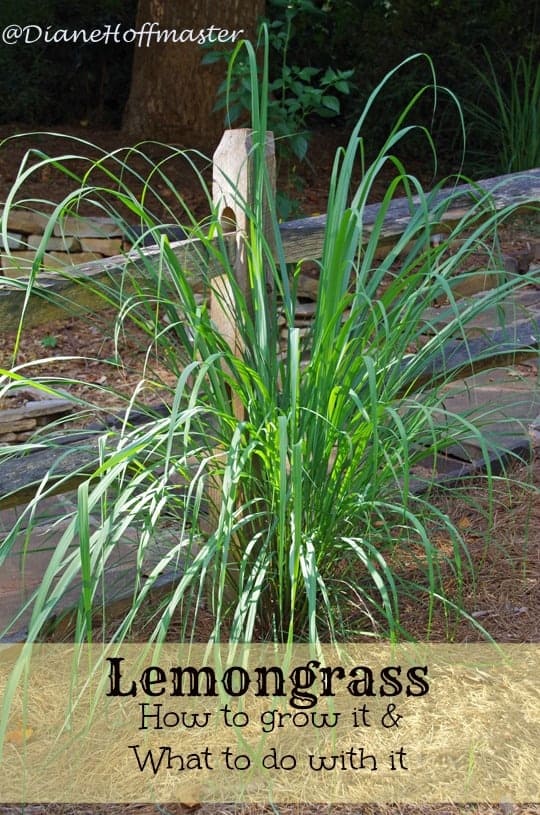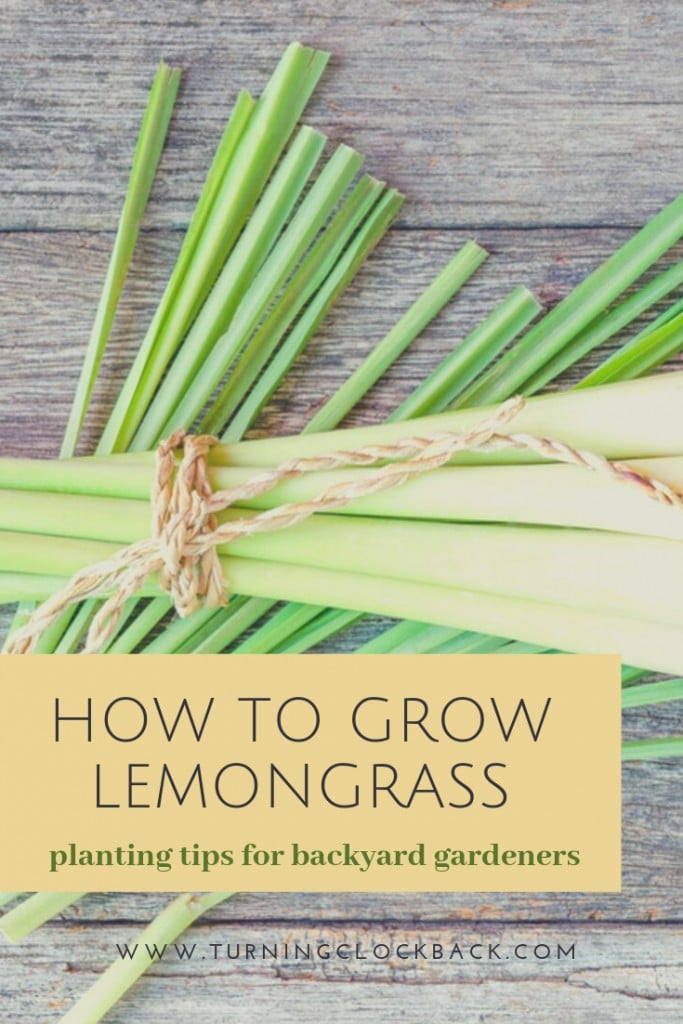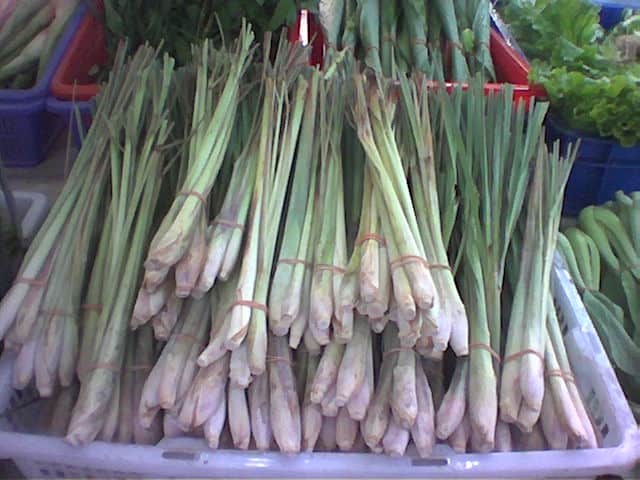Several years ago my husband and I stumbled across a lemongrass plant at a local nursery while we were doing our spring garden shopping. Since both of use are HUGE fans of Thai food (which uses a lot of lemongrass) we picked up a plant to put in the back yard. I had no idea how to grow lemongrass but not having to traipse to the store every time we want to make Thai food sounded like a great plan. Growing lemongrass is actually very easy!
Posts feature partner companies & may be sponsored. Post contains affiliate links & I will be compensated if you make a purchase after clicking on links. As an Amazon Associate I earn from qualifying purchases.
Table of Contents
Is Lemongrass hard to grow?
Ok, so this is going to depend on where you live and the extent of your green thumb. Here in Georgia, growing lemongrass was only as hard as digging the hole and sticking the plant in it. Seriously. We bought a small lemongrass plant at the local nursery.
After that, we just found a sunny spot, dug a hole, and stuck the plant in the ground. Other than regular watering, we just watched the lemongrass grow bigger and bigger with almost no attention at all.
Can Lemongrass Survive Winter?
Growing lemongrass in cold climates can be tricky. Thankfully, I live in the south which makes it a bit easier. If you are growing lemongrass in Florida, you will have much better luck with this project.
Our lemongrass plant THRIVED for several years in our back yard. It grew close to 4 feet tall and almost as wide around at the top. With lots of sun and an average amount of water we had more fresh lemongrass than we could ever possibly use. And then came an unseasonably cold winter. With a full week of single digit temperatures, many of our plants didn’t survive the winter.
More Gardening Ideas
- Urban Gardening Ideas for Small Spaces
- Summer Gardening Tips for a Bountiful Harvest
- Frugal Landscaping Ideas: How to Upgrade Your Yard on a Budget!
✯Don’t want to miss the next post?✯ Follow Turning the Clock Back on Facebook | Twitter | Pinterest Or join the private Facebook group for simple tips on going green!
Winters here in Georgia are usually fairly mild but last year we lost not only the lemongrass but also several varieties of bamboo and my rosemary bush. Mother nature can be cruel and we were forced to start our lemongrass plant as a baby again this past spring. It is doing incredibly well and loves the location we chose for it. If we have a few mild winters it may even be around for a while.
Even if you don’t have a green thumb, I swear you can grow lemongrass without any problems! Buy lemongrass seeds or lemongrass plants and have them delivered!

How to Grow Lemongrass
So, how do you grow lemongrass in your own yard? Obviously, the easiest way to get started is to find a lemongrass plant at your local nursery. There are a few different varieties available, some of which are better for producing essential oil, some of which make larger bulbs, etc.
Talk to your nursery employee about which varieties they carry or check out the National Horticulture Board for descriptions of all the varieties currently available.
The other really easy way to grow lemongrass is to find a bulb at the grocery store that still has a few roots on it. If you put it in water for a few weeks it will start to create a nice root system and you will be able to plant it in your yard.

How to Sprout Lemongrass Stalks
If you find fresh lemongrass at the grocery store, you can try sprouting it yourself and then planting it. Just put the lemongrass stalk into a glass of water in a sunny window. Leave it for about 3 weeks until until it grows roots. Change the water every few days to avoid microbial growth.
Then, fill a small container full of damp potting soil and stick the sprouted lemongrass stalk in the potting soil. Put the root base about one inch below the soil line. Now, just be patient! You can leave it in the pot or eventually transplant it outside. If you like growing food indoors, check out my November planting guide for more suggestions.

Best Conditions for Growing Lemongrass
Ideal conditions to grow lemongrass would be full sun, plenty of water and rich, organic soil. You can plant it directly in the ground or it grows well in containers as well. The bulb of the plant is the part that is most often used as food while the grassy tops make a great tea.
Lemongrass thrives in full sun and well drained soil so choose your location carefully. It will take a couple of months for the plant to be big enough to start harvesting so be patient.
How to Harvest Lemongrass
Once your plant is well established just grab an individual stalk very low to the ground and pull firmly but gently. Try this when the ground is damp after a good rain for best results.
After you have your stalks out of the ground, you want to wash and remove the outermost layers around the base. The part of the lemongrass stalk most often used in cooking is the tender, white interior of the plant.

Lemongrass Plant Uses
So, what can you do with lemongrass? If you bruise the stalk of the lemongrass and put it in soups or stock you will get a wonderfully light lemon flavor. Drying the grassy tops of the plant will give you a wonderful ingredient for tea.
Lemongrass also makes a wonderful ingredient for a DIY herbal steam facial. Just place a few stalks of bruised lemongrass in a bowl and cover with boiling water. Place a towel over your head and put your face over the steaming bowl of lemongrass. This steamy facial will help open up your pores and soften your skin.

Lemongrass has many uses, both in our food and as a medicinal plant. Lemongrass is used to treat stomachaches, high blood pressure, cough, fever, and many other common ailments. Check out WebMD for more detailed medicinal uses for lemongrass.
Fresh Lemongrass Recipes
Lemongrass is an aromatic herb. It has many uses in both food and drinks. If you enjoy the flavor of lemongrass, try this Spicy Lemongrass Soup. You can also make lemongrass tea, which is both delicious and healthy. Check out my lemongrass jelly recipe if you are getting hungry!
Fresh lemongrass tea:
To make lemongrass tea, just bring a pan of water to a boil over high heat. Add your fresh lemongrass stalks and let it simmer for about 10 minutes. Remove the pan from the water and let cool slightly until it is cool enough to drink. Strain the stalks from the liquid and enjoy. You can also chill it in the refrigerator and pour over ice for an iced lemongrass tea.
Love gardening? Learn how to grow thyme and get a few ideas of what to do with it!

Diane is a professional blogger and nationally certified pharmacy technician at Good Pill Pharmacy. She earned her BS in Microbiology at the University of New Hampshire and has worked in cancer research, academics, and biotechnology. Concern over the growing incidence of human disease and the birth of her children led her to begin living a more natural life. She quickly realized that the information she was learning along the way could be beneficial to many others and started blogging and freelance writing to share this knowledge with others. Learn more about her HERE.




Lemon grass is also great for cats. I have a 5′ plant I brought in for the winter. It sits in front of south facing window behind a chair which my cats love to sit on and chew on “their” grass.
I did not know that! Although I have noticed that whenever my dog has a grumbly tummy she heads right for the lemon grass and starts eating it!
so does mine. I planted my two plants in the ground in the fall and hope they grow if not two more will go in the ground
It’s not good for dogs be careful
According to the ASPCA, lemongrass is toxic to dogs due to the oils and cyanogenic glycosides in the plant. But lemongrass poisoning is very rare for dogs since they would have to ingest a large amount to trigger severe symptoms. This means growing lemongrass in your garden is fairly safe even if your dog ingests a small quantity of lemongrass — they should be absolutely fine.
I started my lemon grass plant off with two pieces bought from my local supermarket. Place in clear container with small amount of water and leave for a few weeks. Small root stems will begin to form, leave untill they are approximately 1 inch long and then plant in a pot. I left mine on a window sill untill big enough to plant out.
thanks for the tip! It seems to grow really well here in GA as long as it gets lots of sun and water!
Good post. I am bookmarking this!
I have been told that it helps keep mosquitoes away. Is this true?
it does help keep them away along with citronella plants.
Yes they will keep mosquitoes away. I lived in Florida and ever spring I split the plants apart and planted them at a difference location around my home.
Ours seem to only live a few years before dying. I think when we have a hard freeze they dont make it.
Lemongrass is also a mosquito deterant. They don’t want to be around it. I want one to put by my back door.
They grow pretty big in full sun..leave lots of room!
I have heard that too but have never really tried using it for that.
at the end of fall last year we put our two lemon grass plants in the ground. They are pretty brown does anyone know what step I should take next trim it to the ground and let it grow back up or what? help need some advice.
I leave mine and cut back that dead material about March? (leaving about 8 inches behind). Ours comes back here in Georgia if the winter wasn’t too harsh. If no green shows up by late april or so, I would think it probably didn’t survive the winter.
I live just south of Jax Florida. Last winter I divided my plant by digging it up and separating the stalks, cut back all the green leaves and made fresh tea from the leaves then froze in ice cube trays some with ginger a smidge of raw sugar. Dry the rest for more tea later. I stuck all the small stalks in a glass of water to get new roots and then overwintered the large stalks in pots at a window. This summer my plants was huge that I planted in the ground.I am making more ice cubes of boiled lemongrass and ginger with a tad of raw sugar. My granddaughter loves it.
I love that idea! Lemongrass/ginger ice cubes sound awesome!
Do you make your tea in a glass container, as I have tried in a stainless steel one and it turns purple in color and bitter. Also, how do you dry the leaves, my plant started from 2 or 3 stalks that I rooted and planted and is huge now. I would like to dry the leaves for over the winter so that I could have tea then too. I am in the Northwest Panhandle of Florida.
i have ever only used it fresh, although Im sure there are directions for drying it online. I always make tea in glass so not sure about the stainless steel issue!
How much ginger? Does it have to be fresh?
Chop it down to almost ground level; water it daily; it grows back quickly!
Good to know! We never have had luck getting it to grow for more than a couple years in a row and only if we have a mild winter. I wish it survived longer!
I’m going to give this a try. thanks for the idea.
Good luck! We have had lots of luck with ours!
Hey I just received a delivery of lemongrass seed… unfortunately there are no planting guides.. do you have any idea how to start it from seed? Should I start it inside or can I just put a few seeds outside and keep it well watered? Any advice would be appreciated!
It really depends on where you are located, unfortunately. It really thrives in warm weather and here in the US, we are moving into fall. Seeds like a warm, damp place to germinate and mornings are getting chilly here. Can you try sprouting it indoors and letting it grow til spring and then transplant? Or are you in a different area of the world? If you are moving into spring and summer in your area, you can probably sprout indoors like a regular seed with grow lights and regular watering, then transplant outside once the ground is starting to stay warm.
I GOT A STICK FROM MY AUNT’S PLACE LAST YEAR EARLY IT HAS GROWN SO BIG. i HAVE EVEN TRANSPLANTED IT AND DRIED SOME FOR TEA
I love lemongrass and there are SO many uses for it!
Lemon grass, like spring onions, regrow from the roots just cut off the roots of a stalk you have pulled up and about an inch of white stem. You can plant it straight away or put it on water for a couple of weeks if you want. You will have a nice bushy plant in a few weeks
our whole plant usually comes back up in the spring, at least for a couple of years, if we leave a lot of foliage intact.
Living in deep South Florida, planting a lemon grass “hedge” across my backyard was the worst landscape project I ever did. I did not know it is such an invasive plant. When it produces seed stalks, the seeds blow all over. Before long, plants are popping up all over. And the roots go deep and dense…. almost impossible to eliminate. It’s been well over a year, and I’m still digging out new sprouts all across the yard from the tiniest slither of a prior root left in ground. And, unless the plants get frequent rain or watered, they turn brown almost overnight, roaches love living inside the dense foliage. YUCK, YUCK…
NEVER AGAIN and HIGHLY DO NOT RECOMMEND.
Interesting. I live in Georgia and it only lives for a couple of years and I have never noticed any stray plants growing where I do not put them. I wonder if it matters that variety of lemongrass that you use? I am sorry you had such a tough time of things!
My Lemongrass is about 6 ‘ tall and I love how the wind blows it, I can always tell what direction the wind or rain is coming from, live in center of state (Florida). Easiest way for me to cut back in spring is to tie a cord around it and choke it up tight, Slip a large yard bag down over it, then use my hand saw to cut it all off at the ground level, now it’s bagged.
Great tip! It does get very out of control occasionally!